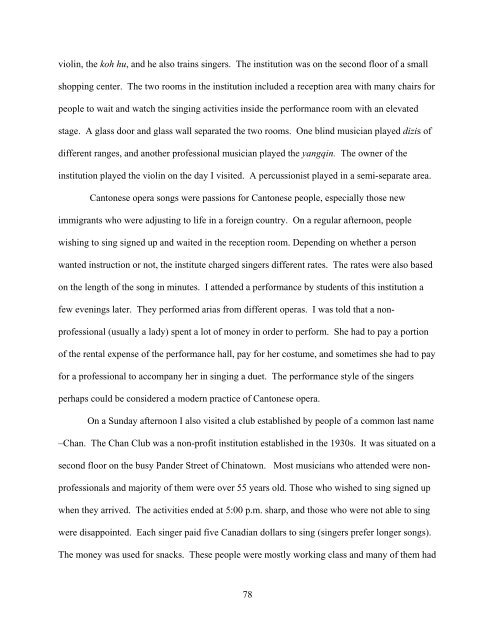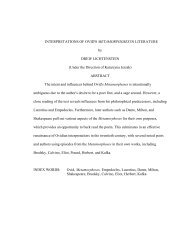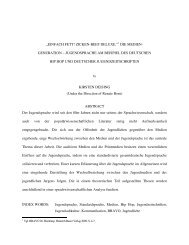RED BOAT TROUPES AND CANTONESE ... - University of Georgia
RED BOAT TROUPES AND CANTONESE ... - University of Georgia
RED BOAT TROUPES AND CANTONESE ... - University of Georgia
You also want an ePaper? Increase the reach of your titles
YUMPU automatically turns print PDFs into web optimized ePapers that Google loves.
violin, the koh hu, and he also trains singers. The institution was on the second floor <strong>of</strong> a small<br />
shopping center. The two rooms in the institution included a reception area with many chairs for<br />
people to wait and watch the singing activities inside the performance room with an elevated<br />
stage. A glass door and glass wall separated the two rooms. One blind musician played dizis <strong>of</strong><br />
different ranges, and another pr<strong>of</strong>essional musician played the yangqin. The owner <strong>of</strong> the<br />
institution played the violin on the day I visited. A percussionist played in a semi-separate area.<br />
Cantonese opera songs were passions for Cantonese people, especially those new<br />
immigrants who were adjusting to life in a foreign country. On a regular afternoon, people<br />
wishing to sing signed up and waited in the reception room. Depending on whether a person<br />
wanted instruction or not, the institute charged singers different rates. The rates were also based<br />
on the length <strong>of</strong> the song in minutes. I attended a performance by students <strong>of</strong> this institution a<br />
few evenings later. They performed arias from different operas. I was told that a non-<br />
pr<strong>of</strong>essional (usually a lady) spent a lot <strong>of</strong> money in order to perform. She had to pay a portion<br />
<strong>of</strong> the rental expense <strong>of</strong> the performance hall, pay for her costume, and sometimes she had to pay<br />
for a pr<strong>of</strong>essional to accompany her in singing a duet. The performance style <strong>of</strong> the singers<br />
perhaps could be considered a modern practice <strong>of</strong> Cantonese opera.<br />
On a Sunday afternoon I also visited a club established by people <strong>of</strong> a common last name<br />
–Chan. The Chan Club was a non-pr<strong>of</strong>it institution established in the 1930s. It was situated on a<br />
second floor on the busy Pander Street <strong>of</strong> Chinatown. Most musicians who attended were non-<br />
pr<strong>of</strong>essionals and majority <strong>of</strong> them were over 55 years old. Those who wished to sing signed up<br />
when they arrived. The activities ended at 5:00 p.m. sharp, and those who were not able to sing<br />
were disappointed. Each singer paid five Canadian dollars to sing (singers prefer longer songs).<br />
The money was used for snacks. These people were mostly working class and many <strong>of</strong> them had<br />
78






